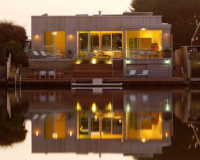Montecito Residence

Photo courtesy Tim Bies/Olson Sundberg Kundig Allen Architects

Photo © Jim Bartsch

Photo © Nikolas Koenig

Photo courtesy Tim Bies/Olson Sundberg Kundig Allen Architects

Photo © Nikolas Koenig

Photo © Nikolas Koenig

Photo © Nikolas Koenig

Photo courtesy Tim Bies/Olson Sundberg Kundig Allen Architects

Image courtesy Olson Sundberg Kundig Allen Architects

Image courtesy Olson Sundberg Kundig Allen Architects










Architects & Firms
Last November in Montecito, California, wildfire consumed almost 2,000 acres, destroying over 100 homes. It wasn’t the first major fire in the area, and it won’t be the last. An arid climate, high winds, scrubby vegetation, and rugged coastal terrain all contribute to the fire-prone nature of the area. And yet, the region’s beauty and proximity to Santa Barbara and Los Angeles make it a highly desirable address.
To build a house in such a high-risk area calls for more than a lovely design. It calls for fortification. This residence, built on five acres at the top of a lone promontory high above Montecito (and only three miles from where the November fires did their worst damage), with its unusual geometries and mix of industrial materials and glass, is both. According to Tom Kundig, FAIA, principal of Seattle-based firm Olson Sundberg Kundig Allen Architects (OSKA), the site had been graded and an 18,000-square-foot Spanish-revival-style home had been designed for it before the project was canceled and his clients purchased the land. “Our clients bought a devastated site,” says Kundig, referring to the destruction wreaked by the grading, “and began the slow and costly process of restoring it. That process is still underway.” In a recent interview with RECORD, Kundig spoke about the dual role of a residence as both a shelter from the elements and as a place to interact with them. His clients, a retired couple, first saw OSKA’s work in an architectural publication. According to Kundig, their requirements were straightforward. “They were very clear and consistent with their needs,” he says. “The program was to embrace the natural landscape rather than create over-indulged architecture. They wanted a small house that would meet their daily needs and have space for occasional guests.”
Constructed of simple, fire-resistant materials, such as steel and concrete, the 2,900-square-foot house was designed to benefit from the very same elements that make its site so dangerous. The raised roof acts as an umbrella to shield the house from the sun, while glazed walls on the west side allow stellar bay views. With three bedrooms and three and a half baths, the house is arranged around a long central hallway that creates an axis dividing public from private spaces, and allows breezes to pass through. To the east lies the public entrance, what Kundig calls “the world’s tallest Dutch door--it acts as the ventilator for breezes and mitigates the need for the air conditioner.” The garage and road are also to the east while, to the west, are the garden, pool, and guest rooms.
The house achieves the clients’ simple goals, and the more complex need to keep high winds and potential fires at bay. “The underlying intention of the home is that it builds naturally from the context of the site and the functional needs of the owners,” he says. “What surprises me most is how peaceful it feels to be here—to be in such an intense and vulnerable place.” It seems that with the right home, living in such a rugged part of the world just may be worth the risk.
PeopleArchitect Principal in Charge: Project Manager: Staff Architect: Interiors: Interior designer: Engineer(s): Consultant(s) Other: General contractor: Photographer(s) Nikolas Koenig, agent is: CAD system, project management, or other software used: |
ProductsStructural system: Exterior cladding Roofing Aluminum: Doors Interior finishes Paints and stains: Wallcoverings: Special surfacing: Floor and wall: Furnishings Tables: Upholstery: Other furniture (use additional sheet if necessary): Lighting Plumbing |











